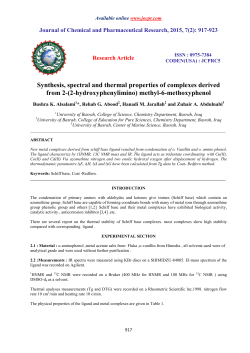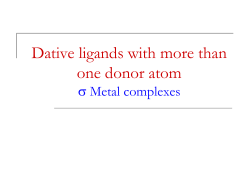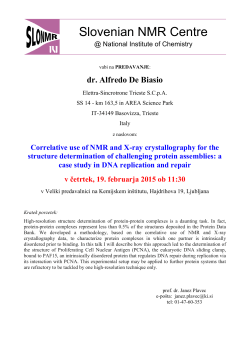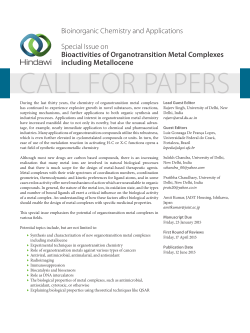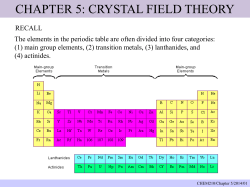
Synthesis and Characterization of Some Novel - Blogs at H-SC
H-SC Journal of Sciences (2015) Vol. IV Asuigui and Deifel Synthesis and Characterization of Some Novel Tetradentate Schiff Base Ligands and their Metal(II) Complexes Dane Romar C. Asuigui ’16 and Nicholas P. Deifel Department of Chemistry, Hampden-Sydney College, Hampden-Sydney, VA 23943 Introduction Schiff bases are functional groups derived from the condensation of amines and aldehydes, that is, the formation of carbon-nitrogen double bonds by interaction of amines and carbonyls. Incidentally, the Nitrogen acts as a ligand, or base, in which it readily donates an electron from its electron pair to a metal ion. The functionality of these ligands and their metalcomplexes are the focus of much coordination and 1,2 structural chemistry studies. These same studies lead to the observation of various properties that are 3 4,5 luminescent, photochromic and thermochemical, 6-9 and magnetic and electrochemical in nature. 10 Furthermore, biological studies involve the many types of metal complexes afforded by such ligands 11-14 and even provide antibacterial, or antimicrobial, 15 and antifungal properties. In many Schiff base studies, their effectiveness as catalysts is studied and 16-19 utilized in many types of reactions. In the copolymerization of CO2 with epoxides, a Co(II) complex of a Schiff base ligand facilitates the order and binding of CO2 and epoxides, making it an 20-21 effective catalyst. Similarly, a Cu(II) complex of a Schiff base ligand was found to stabilize DNA for controlled binding of two separate DNA, acting as a 22 scaffold to allow both structures to bind easily. Scheme 1. The imines may be found in the ortho-position or, in this case, the meta-position. R denotes various halides and groups; the imines (N-C) and alcohols (OH) are coordination sites that give the ligand its tetradenticity. Scheme 2. Metal coordination was performed on the metaposition diimines. The pair of electrons on the Nitrogen (N) and the unpaired electron on the Oxygen (O) coordinate to the metal(II) ion to form the complex. The synthesis, characterization, and metal coordination of some novel and existing Schiff base ligands are studied in this project. Because there are various types of Schiff base ligands, those that will be studied are specified to symmetrical, tetradentate ligands: these are a 1:2 combination of a phenylenediamines and salicylaldehydes (Scheme http://sciencejournal.hsc.edu/ 1). The term –dentate refer to the molecules ability to “bite down” onto metal ions; this is also known as denticity. Being tetradentate describes a number of four sites to which metal ions may attach to. Their metal complexes will involve metal(II) ions of copper, nickel, or zinc (Scheme 2). These metals are often coordinated to Schiff base ligands and have been 23-25 studied together in a number of journals. Their data will aid in characterizing the metal complexes studied in this project by comparing this project’s data to existing ones The synthetic process for Schiff bases, as described briefly, involves hours of condensation of two reagents: amines and aldehydes. This common synthetic method requires a solvent such as methanol or ethanol in which both reagents shall dissolve in, and a catalyst, usually an acid. Though simple and quite efficient, this method is sometimes modified or abandoned for more environmental and economic methods, such as those that do not require 26 solvents. For this project, the common synthetic method will not be employed. Instead, a more rapid and efficient method using copper nitrate catalyst 27 without the need of reflux, or condensation of reagents, is preferred. Materials and Methods All syntheses were carried out under a single fume hood. Reagents and solvents were not altered or purified in any way for use and were obtained mostly from Sigma-Aldrich. Instruments used for manipulation or analysis of product include a hydraulic pellet press, Fourier Transform Infrared (FTIR) and Nuclear Magnetic Resonance (NMR) spectrometer, and later, X-ray Diffraction spectrometer. General Synthesis of Schiff Base Ligands 17: Liquid salicylaldehydes were weighed into a 50 ml round bottom flask. (Salicylaldehyde has a density of 1.146 g/ml, meaning its measured weight shall deviate; additionally, this reagent will not act as the limiting reagent and the calculated amount will be increased by an additional 5% by mol.) 20-30 mL of ethanol is added to the salicylaldehydes to dissolve— some mixing, by addition of a stir bar and a stir plate may be necessary if the salicylaldehydes do not dissolve. In a 50 ml beaker, phenylenediamines were weighed out and dissolved in 10-20 ml ethanol. The solutions of phenylenediamines are added to the solution of salicylaldehydes slowly, via addition funnel. A small amount of copper nitrate (about 1 mol %) is added to the solution. It is then stirred for at least 30 minutes. The product is either filtered and H-SC Journal of Sciences (2015) Vol. IV Asuigui and Deifel washed with cold ethanol or forced to precipitate with the addition of 50 ml of deionized water and later filtered. The product is air-dried and prepped for further analysis. General Synthesis of Metal(II) Complexes 810: A reflux setup is required for the metal coordination reactions: a heating mantel, condenser, stir plate, and hoses, to allow water to cool the condenser, are necessary for the setup. Ligands were weighed onto a 50 ml round bottom flask. A 4:3 mix of methanol and chloroform is added to dissolve the ligand. This flask of solution is placed over a heating mantle and allowed to stir between 60-80̊ C for 5 minutes. Metal acetates are dissolved in methanol and added to the solution slowly. Afterwards, the solution is refluxed for a total of 3 hours. The end solutions may remain clear and are left in a refrigerator overnight (12-24 hours) to allow crystals to form. If no crystals form, the solution can be filtered or washed and air-dried. carbons aid in identifying the existence of the synthesized Schiff base ligands. Results and Conclusion Dried samples of the Schiff base ligands and 1 13 metal complexes were obtained. For H and C NMR experiments, the Schiff base ligands were dissolved in deuterated NMR solvents. Being deuterated gives the NMR solvents, such as chloroform, acetone, or dimethyl sulfoxide, hydrogen containing a pair of nuclei: both a proton and a neutron. Having a pair of nuclei will prevent the NMR instrument from detecting the single nuclei hydrogens as they will have no interaction with the magnetic field. The Schiff base ligand products were first dissolved in cheaper, nondeuterated solvents in order to find a proper NMR solvent for the NMR experiments. For ligands 1-7, 520 mg of sample dissolved in 1 ml of their respective solvents. 1 The data obtained from H NMR experiments display shifts of multiple hydrogens found on the molecule. These shifts are integrated and a reference shift—one that can be assigned to a particular proton on the molecule—is marked. By assigning the reference shift an integral number of 1 or the actual number of that hydrogen in one molecule, the integral values of the other shifts can be counted and matched with the actual amount of hydrogen found in 13 one molecule. For C NMR experiments, the unique carbon molecules on in the Schiff base ligands are 13 observed (there are about 1% of C in carbons found in nature, making them ‘unique’). The number of shifts, their general shift values, and their heights give information about where and roughly how many carbon molecules are found in the sample. In Table 1, a set of spectral data from some of the best data obtained are shown. The impurities 28 and solvents are easily identified, while the hydrogen integral values and number of unique http://sciencejournal.hsc.edu/ Table 1. NMR Spectral Data 1 (CDCl3) 1 4 (CDCl3) 2 ((CD3)2CO) H (ppm) b 12.36 (s, 1H) 7.31-7.49 (m, 6H) 8.72 (s, 2H) 8.85 (s, 2H) 7.12-7.22 (m, 2H) 6.90-7.10 (m, 4H) a 2.15 (s) 7.99-8.07 (m, 4H) 7.46-7.48 (m, 4H) 7.25 (d, 1H) 7.03 (m, 4H) 6.76 (m, 2H) c 4.74 (s, 3H) d 1.56 (s) e 1.25 (s) 7.61-7.65 (d, 2H) 7.42-7.48 (m, 2H) 7.22-7.26 (d, 1H) 7.08-7.13 (d, 2H 6.95-7.04 (m, 3H) c 4.85 (s) f 2.08 (s) g 2.04 (q) 163.44 164.78 165.35 161.27 160.87 160.96 149.82 146.96 133.75 133.55 132.56 130.41 139.32 134.29 133.04 133.27 119.58 119.35 119.70 119.29 124.49 119.87 117.07 116.86 119.17 117.42 114.04 119.10 117.37 114.81 105.83 105.59 153.50 13 12.39 (s, 1H) b 8.66 (s, 2H) C (ppm) 113.83 155.80 b c acetone 2H expected—possible deuteration amine from phenylenediamine impurities—this affects 4 by having too many H in d e f&g the aromatic region water ethanol solvent/acetone a -1 Table 2. IR Bands (cm ) Cmpds νO-H νC=N νC-O νN-M νO-M Ligand 2 3385 1566 1119 - - Cu(II) - 1594 1107 546 502 Ni(II) Zn(II) - 1606 1591 1136 1148 530 522 503 469 The IR Data obtained gives information on the existence of specific bonds found in the ligands and metal complexes. The bonds in the molecules have different modes of vibration that the FTIR instrument detects and displays in a spectra form. These bonds are consistent in many molecules, so that identifying the presence of the bonds by comparing with known values is done. To determine that the Schiff base ligand 2 was metal-coordinated, the metal-oxygen and metal-nitrogen bonds were found on the spectra and compared with the values of 29-30 spectra reported in journals. The values of these bonds were consistent, giving some proof that the Schiff base ligand had been metal-coordinated. Table 2 displays some of the shifts in the spectra. H-SC Journal of Sciences (2015) Vol. IV By employing an alternative method to synthesize Schiff base ligands, a novel Schiff base ligand was found. And due to the ability of a ligand to bind to metals, additional three metal complexes were synthesized. The use of powerful instruments, like the NMR and FTIR, provided characterization to confirm the presence of the target ligands and complexes. In the future, these compounds should yield crystals to allow X-ray crystallography experiments to determine fully, the molecular details of the compounds. The search for a novel ligand has been successful in this project and will continue, given the variety of Schiff base ligands that have not yet been synthesized. Studies on the properties of these novel ligands will also produce interest in other fields of chemistry and science, as a result of numerous properties displayed by many Schiff base ligands. In the future, more metal complexes may be synthesized and characterized. Other methods that may yield a higher percentage of products can also be useful, and a process to do so can be studied and found. Future work may include studying the synthesis of Schiff base ligands and their metal complex, so that a better or more efficient and novel method may be utilized. This type of study will involve different types of experiments and additional sets of instruments. This project would aid in the overall study of the Schiff base ligands, their metal complexes, and synthetic chemistry, as a whole. Asuigui and Deifel 6. 7. 8. References 1. Wang, Y.; Lui, Z.; Gao, J. Y. (3,5Dichlorosalicylaldehyde 3 1 thiosemicarbazonato-κ S,N ,O)(N,N'dimethyl-formamide-κO)copper(II) dimethylformamide Solvate. Acta Crystallogr., Sect. E: Struct. Rep. [Online] 2008¸ E64, m633634. http://journals.iucr.org/e/issues/2008/05/00/o m2219/om2219.pdf (accessed Aug 8, 2014). 2. Giricheva, N. I.; Girichev, G. V.; Kuzimina, N. P.; Medvedeva, Yu. S.; Rogachev, A. Yu. Structure of the Cu(salen) Molecule CuO2N2C16H14 According to Gas-phase Electron Diffraction Data and Quantum Chemical Calculations. J. Struct. Chem. 2009, 50, 52-59. 3. Archer, R. D.; Chen, H.; Thompson, L. C. Synthesis, Characterization, and Luminescence of Europium(III) Schiff Base Complexes. Inorg. Chem. 1998, 37, 20892095. 4. Safin, D. A.; Robeyns, K.; Garcia, Y. Solidstate thermo- and Photochromism in N,N'bis(5-X-salicylidene)diamines (X = H, Br). RSC Adv. 2012, 2, 11379-11388. 5. Li, C.-H.; Tao, L.-M.; Xiao, S.-X.; Li, A.-T.; Jiang, J.-H.; Li, X.; Yao, F.-H.; Luo, W.-P.; http://sciencejournal.hsc.edu/ 9. 10. 11. 12. Xie, J.-Q.; Peng, M.-N.; Pan, L.; Li, Q.-G. Thermochemical Study on the Schiff Base [H2salen = N,N'-bis(salicylidene) ethylendiamine] and Its Binuclear Copper (II) Complex. Thermochim. Acta 2013, 569, 97103. Kakuta, Y.; Masuda, N.; Kurushima, M.; Hashimoto, T.; Yoshioka, D.; Sakiyama, H.; Hiraoka, Y.; Handa, M.; Mikuriya, M. Synthesis, Crystal Structures, Spectral, Electrochemical and Magnetic Properties of di-µ-phenoxido-bridged Dinuclear Copper(II) Complexes with N-salicylidene-2hydroxybenzylamine Derivatives: Axial Coordination Effect of Dimethyl Sulphoxide Molecule. Chem. Pap. 2014, 68, 923-931. Menati, S.; Azadbakht, A.; Taeb, A.; Kakanejadifard, A.; Khavasi, H. R. Synthesis, Characterization and Electrochemical Study of Synthesis of a New Schiff Base t (H2cddi butsalen) ligand and Their Two Asymmetric Schiff Base Complexes of Ni(II) and Cu(II) with NN'OS Coordination Spheres. Spectrochim. Acta, Part A 2012, 97, 10331040. Saha, D.; Sasmal, A.; Choudhury, C. R.; Gόmez-Garcia, C. J.; Garribba, E.; Mitra, S. A New Linear Double Phenoxide-bridged Trinuclear Cu(II) Schiff Base Complex: Synthesis, Crystallographic Elucidation, Magneto-structural Correlation and DFT Study. Polyhedron. 2014, 69, 262-269. Ulusoy, M. Karabıyık, H.; Kılınçarslan R.; Aygün, M.; Cetinkaya, B.; García-Granda, S. Co(II) and Cu(II) Schiff base complexes of bis(N-(4-diethylamino-2-methylphenyl)-3,5-ditert-butylsalicylaldimine): Electrochemical and X-ray Structural Study. Struct. Chem. 2008, 19, 749-755. Kalita, A.; Deka, R. C.; Mondal, B. Reaction of a Copper(II)—Nitrosyl Complex with Hydrogen Peroxide: Phenol Ring Nitration Through a Putative Peroxynitrite Intermediate. Inorg. Chem. 2013, 52, 1089710903. Baykara, H.; Ilhan, S.; Levent, A.; Seyitoglu, M. S.; Özdemir, S.; Okumuş, V.; Öztomsuk, A.; Cornejo, M. Synthesis, Characterization and Experimental, Theoretical, Electrochemical, Antioxidant and Antibacterial Study of a New Schiff Base and Its Complexes. Spectrochim. Acta, Part A. 2014, 130, 270-279. Garza-Ortiz, A.; Camacho-Camacho, C.; Sainz-Espuñes, T.; Rojas-Oviedo, I.; Gutiérrez-Lucas, L. R.; Carrillo, A. G.; Ramirez, M. A. V. Novel Organotin(IV) Schiff Base Complexes with Histidine Derivatives: Synthesis, Characterization, and Biological H-SC Journal of Sciences (2015) Vol. IV 13. 14. 15. 16. 17. 18. 19. 20. 21. 22. Activity. Bioinorg. Chem. Appl. 2013, 2013, 112. Saha, N. C.; Pradhan, R.; Das, M.; Khatun, N.; Mitra, D.; Samanta, A.; Slawin, A. M. Z.; Jana, A. D.; Klanke, J.; Rentschler, E. Synthesis, Characterization, X-ray, Crystallography, and Antimicrobial Activities of Ni(II) and Cu(II) Complexes with Salicylaldehyde-based Thiosemicarbazone Ligand. Coord. Chem. 2014, 67, 1-14. Chang, E. L.; Simmers C.; Knight D. A. “Cobalt Complexes as Antiviral and Antibacterial Agents” Pharmaceuticals. 2010, 3, 1711-1728. Guzzi, S. A. B.; Alagi, H. S. E. Synthesis, Characterization and Antimicrobial Studies on Nickel (II) and Copper(II) Complexes of 2N2O2 Donor Schiff Base. Chem. Sin. 2013, 4, 62-66. Abbasi, Z.; Behzad, M.; Ghaffari, A.; Rudbari, H. A.; Bruno, G. Mononuclear and Dinuclear Salen Type Copper(II) Schiff Base Complexes: Synthesis, Characterization, Crystal Structures and Catalytic Epoxidation of Cyclooctene. Inorg. Chim. Acta 2014, 414, 78-84. Larrow, J. F.; Jacobsen, E. N.; Asymmetric Processes Catalyzed by Chiral (Salen)Metal Complexes. Top. Organomet. Chem. 2004, 6, 123-152. Machado, K.; Tavares, P. B.; Freire, C.; Mishra, G. S. Single Site Anchored Novel Pentacoordinate Schiff-base Co(II) Complexes Over SBA-15 for Selective Oxidation (O2) of n-alkanes and Kinetic Study. Polyhedron. 2014, 69, 119-126. Zhuang, X.; Oyaizu, K.; Niu, Y.; Koshika, K.; Chen, X.; Nishide, H. “Synthesis and Electrochemistry of Schiff Base Cobalt(III) Complexes and Their Catalytic Activity for Copolymerization of Epoxide and Carbon Dioxide” Macromol. Chem. Phys. 2010, 211, 669-676. Darensbourg, D. J.; Mackiewicz R. M.; Rodgers, J. L., Fang C. C.; Billodeaux D. R.; Reibenspies, J. H. “Cyclohexane Oxide/CO2 Copolymerization Catalyzed by Chromium (III) Salen Complexes and NMethylimidazole: Effects of Varying Salen Ligand Substituents and Relative Cocatalyst Loading” Inorg. Chem. 2004, 43, 6024-6034. Li, M.-J.; Lan, T.-Y.; Lin, Z.-S.; Yi, C.; Chen, G.-N. Synthesis, Characterization, and DNA Binding of a Novel Ligand and Its Cu(II) Complex. J. Biol. Inorg. Chem. 2013, 18, 993-1003. Naeimi, H.; Moradian, M. Efficient Synthesis and Characterization of Some Novel NitroSchiff Bases and Their Complexes of http://sciencejournal.hsc.edu/ Asuigui and Deifel 23. 24. 25. 26. 27. 28. 29. 30. Nickel(II) and Copper(II). J. Chem. 2013, 2013, 1-8. Li, W.-Y.; Zhang, Y.-J.; Dong, X.-Y.; Li, X.; Wang, L. Synthesis and Structural Characterization of Copper(II) Complex with Asymmetrical Salen-Type Bisoxime Ligand. Asian J. Chem. 2013, 25, 5084-8086. Asadi M.; Sepehrpour H.; Mohammadi K. Tetradentate Schiff Base Ligands of 3,4diaminobenzophenone: Synthesis, Characterization and Thermodynamics of Complex Formation with Ni(II), Cu(II), and Zn(II) Metal Ions. J. Serb. Chem. Soc. 2011. 76, 63-74. Tella, A. C.; Osunniran, W. A.; Owalude, S. O.; Olabemiwo, O. M. Synthesis and Characterization of Some Transition Metal Complexes of Bis(2-hydroxy-4methoxyacetophenone) Ethylenediimine. The Experiment 2013, 16, 1123-1129. Shockravi, A.; Sadeghpour, M.; Olyaei, A. Simple and Efficient Procedure for the Synthesis of Symmetrical Bis-Schiff Bases of 5,5'-Methylenebis(2-aminothiazole) Under Solvent-free Conditions. Synth. Commun. 2010, 40, 2531-2538. Mobinikhaledi, A.; Steel P. J.; Polson M. Rapid and Efficient Synthesis of Schiff Bases Catalyzed by Copper Nitrate. Synth. React. Inorg., Met.-Org., Nano-Met. Chem. 2009, 39, 189-192. Gottlieb, H. E.; Kotlyar, V.; Nudelman, A. NMR Chemical Shifts of Common Laboratory Solvents as Trace Impurities. J. Org. Chem. 1997, 62, 7512-7515. Naeimi, H.; Rabiei, K.; Salimi, F. Efficient, Mild and One Pot Synthesis of N,N'Bis(salicylidene)arylmethanediamines via Three Component Reaction Under Solvent Free Conditions. Bull. Korean Chem. Soc. 2012, 29, 2445-2448. Asadi M.; Sepehrpour H.; Mohammadi K. Tetradentate Schiff Base Ligands of 3,4diaminobenzophenone: Synthesis, Characterization and Thermodynamics of Complex Formation with Ni(II), Cu(II), and Zn(II) Metal Ions. J. Serb. Chem. Soc. 2011. 76, 63-74.
© Copyright 2025

